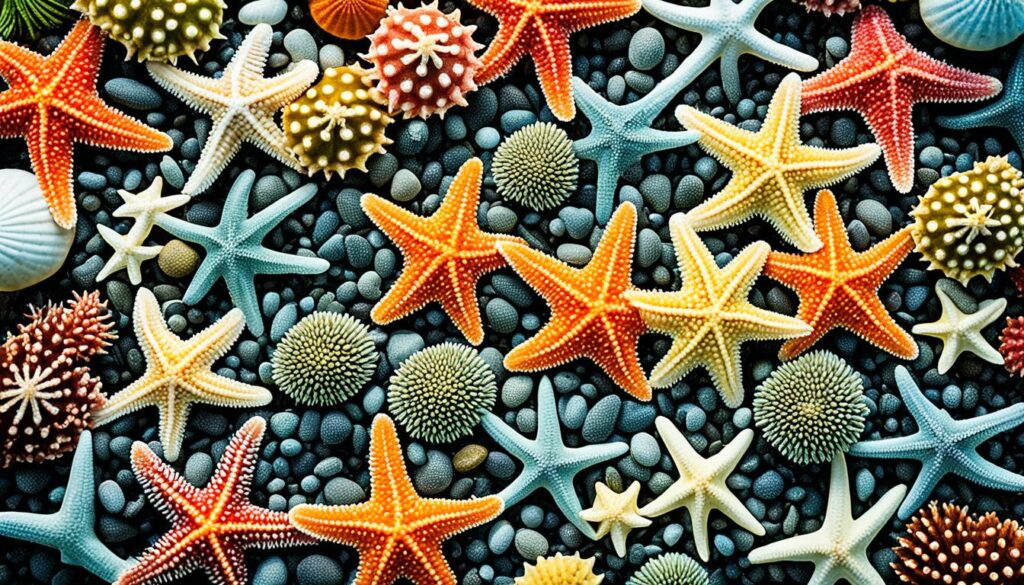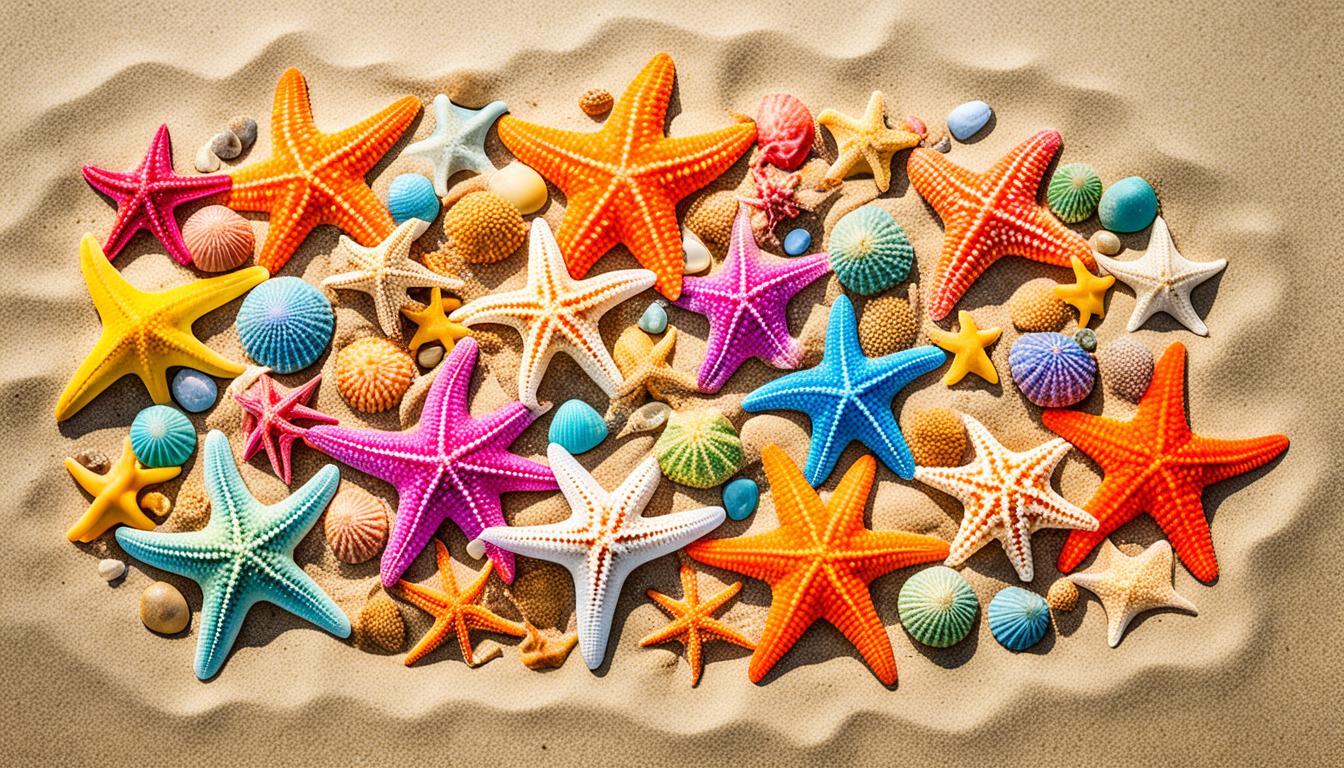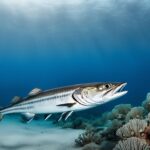Starfish, or sea stars, are a fascinating group of marine animals. They belong to the class Asteroidea and the phylum Echinodermata. There are about 2,000 species of starfish, each with unique traits. These traits help them live in different marine environments.
From the colorful ones in shallow coral reefs to the mysterious ones deep in the ocean, starfish are amazing. They can even regrow lost limbs, which helps them survive. This ability makes them interesting to study.
Learning about starfish classification shows how important they are to the ocean. They play a key role in keeping the marine ecosystem balanced. This makes them a vital part of the ocean’s health.
Introduction to Starfish Diversity
The ocean is home to a wide variety of starfish, showing how adaptable these creatures are. They live in many places, from warm to cold waters. Each starfish has its own look, size, and color, making them stand out.
Starfish have a main body with arms coming from it. Most have five arms, but some can have up to fifty. This variety helps them live in many places, from shallow waters to the deep sea.
Starfish are important in the ocean’s balance. They help the food web by being both hunters and prey. Their special traits help them survive and make the ocean richer. Learning about different starfish helps us see how they play a big role in the sea.
What are the different species of starfish?
Starfish, with their unique shapes and bright colors, come in many types. Some live in shallow coastal waters, while others go deeper in the ocean. Knowing about these differences helps us see how diverse they are.
Examples include Asterias rubens, the common starfish, and the sunflower sea star, Pycnopodia helianthoides. Each starfish has traits that help them survive underwater. The common starfish can regrow lost arms, which is very useful. The sunflower sea star, with up to 24 arms, moves better and catches more prey, like sea urchins.
There’s a big difference between common and rare starfish types. The Crown of Thorns starfish eats coral, which hurts coral reefs. But, many rare starfish help control other sea creatures, keeping their homes balanced.

Overview of Starfish Classification
Starfish, also known as members of the class Asteroidea, are vital to marine ecosystems. They belong to the Echinodermata phylum, along with sea urchins and sand dollars. Learning about their classification helps us appreciate the diversity of life in the ocean. This section will cover key biological aspects of starfish classification and highlight important families.
Understanding Asteroidea and Echinoderms
The class Asteroidea is known for its unique body structure. Starfish have a five-point radial symmetry that makes them stand out. They have a central disc and radiating arms, which help them move and feed. These features are key to their survival in different ocean habitats.
Understanding starfish classification shows their importance in the ocean. It helps us see their diverse roles in keeping the marine environment balanced.
Important Starfish Families
Within the class Asteroidea, there are many starfish families, each with its own diversity and adaptations. Some notable families include:
- Asteriidae: This family includes the common starfish, known for its five arms and varied colors.
- Goniasteridae: This family has the cushion starfish, with thick, fleshy arms and many colors.
- Ophidiasteridae: These starfish have long arms and live in deeper waters.
Each starfish family has unique traits and adaptations. Knowing these families helps us understand their roles in the ocean. They play important roles, from scavenging to predation.
| Family | Common Name | Key Characteristics |
|---|---|---|
| Asteriidae | Common Starfish | Five arms, vibrant colors |
| Goniasteridae | Cushion Starfish | Thick arms, fleshy texture |
| Ophidiasteridae | Elongated Starfish | Long arms, deep-water habitat |
In summary, understanding starfish classification and the families within it shows their complexity and importance in the ocean.
Common Types of Starfish and Their Unique Traits
Several starfish types stand out for their beautiful looks and unique behaviors. Learning about these starfish helps us understand their role in nature and how they adapt.
Sunflower Sea Star
The Sunflower Sea Star is a vibrant example of starfish diversity. It has up to 24 arms, letting it move fast on the ocean floor. Its bright colors help it hide and hunt, catching sea urchins and other creatures.
This starfish’s eating habits affect the ocean’s balance. Its role as a predator shows how starfish traits impact the ecosystem.
Crown of Thorns Starfish
The Crown of Thorns Starfish, or Acanthaster planci, is known for harming coral reefs. It has venomous spines and eats a lot of coral. When there are too many, it causes big problems for coral reefs.
This starfish can quickly recover from being eaten, helping it live in many ocean places. Knowing about these starfish helps us understand their effects on coral reefs.
| Starfish Type | Scientific Name | Main Traits | Ecological Role |
|---|---|---|---|
| Sunflower Sea Star | Pycnopodia helianthoides | 24 arms, vibrant color, fast mover | Predator of marine invertebrates |
| Crown of Thorns Starfish | Acanthaster planci | Venomous spines, coral predator | Impacts coral reef health |
Rare and Exotic Starfish Varieties
Exploring rare starfish reveals their stunning beauty and unique traits. The Necklace Starfish, known as Fromia monilis, is a standout with its bead-like patterns and bright colors. It lives in the Indian Ocean and Western Pacific, showing off starfish traits that amaze us.
Necklace Starfish Characteristics
The Necklace Starfish has a wide range of colors, from soft yellows to deep oranges. Its patterns look like a necklace. This look helps it hide from predators and is key to its survival.
It’s part of the diverse starfish types, adding to coral reef ecosystems. This highlights the need to protect these habitats.
Chocolate Chip Sea Star Overview
The Chocolate Chip Sea Star (Protoreaster nodosus) is another rare starfish type. It’s known for its chocolate chip-like texture and bright colors. It lives in shallow coral reefs in the Indo-Pacific region.
Its unique look and strong build play a big role in its environment. Learning about this starfish deepens our understanding of marine life and the complex ecosystems under the sea.
FAQ
What are the different species of starfish?
There are about 2,000 starfish species, also known as sea stars, in the class Asteroidea. They live in many places, from shallow coral reefs to deep-sea areas.
What are the main types of starfish?
Starfish include common types like the Asterias rubens (common starfish) and the Pycnopodia helianthoides (sunflower sea star). There are also rare species with unique traits and adaptations.
How are starfish classified?
Starfish are classified under the phylum Echinodermata and the class Asteroidea. Families like Asteriidae, Goniasteridae, and Ophidiasteridae have many species with different traits.
What unique traits do common types of starfish have?
Common starfish, like the sunflower sea star, have bright colors and can move well. The Crown of Thorns starfish have special ways to eat that help them survive in their homes.
What are some examples of rare starfish varieties?
Rare starfish include the Necklace Starfish with its bead-like patterns and the Chocolate Chip Sea Star with its unique texture. These show the wide variety in marine life.







